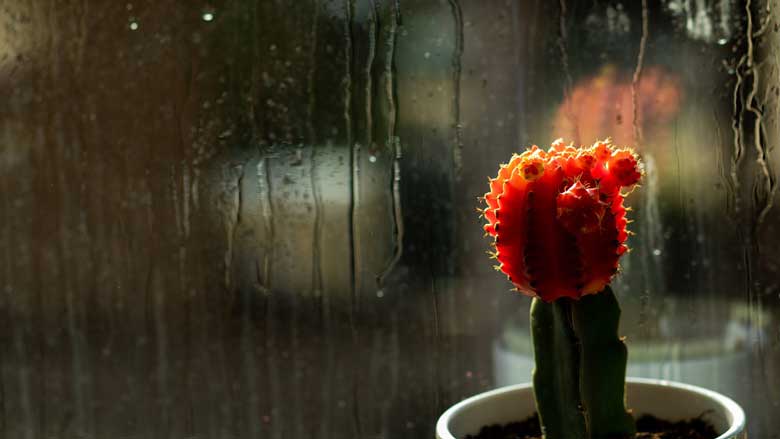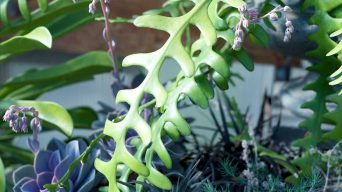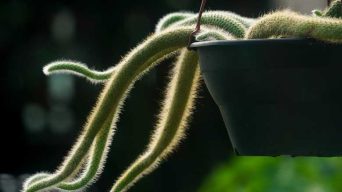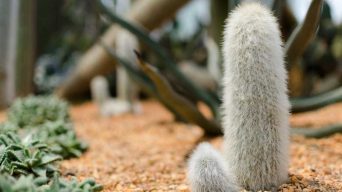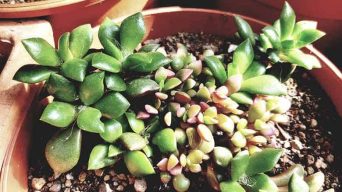Succulents are very popular plants, not only because of their unusual appearance but also because they are easy to be grown by both beginning and advanced growers.
The Gymnocalycium mihanovichii, commonly known as the Moon Cactus, is a typical, highly desirable, and widely-grown type of succulent.
This plant is often sold as a beginner’s succulent and is well-known as one of the friendliest cactus plants to grow.
In this article, you can read all about the care and propagation of Gymnocalycium mihanovichii (Moon Cactus).
Overview
Gymnocalycium mihanovichii is a species of globular cactus from the Cactaceae family and native to South America.
The Gymnocalycium mihanovichii has a broad-spherical overgrown plant body that can reach 3 to 5 cm in height and diameter.
The most popular Gymnocalycium cultivars are mutations that lack chlorophyll and display pink, red, orange, or yellow coloring.
These strains are frequently grafted onto the Hylocereus cactus, resulting in a grafted cactus, the “Moon Cactus”.
The soft, flexible, and somewhat curved thorns are greyish-yellow and range in length from 0.8 to 1 cm.
The bell-shaped flowers are yellowish-olive to light olive green and measure 4-5 cm in length.
The Gymnocalycium mihanovichii is commonly known as Moon Cactus, although it is sometimes referred to as:
- Ruby Ball Cactus
- Red Cap
- Red Hibotan
- Hibotan Cactus
- Oriental Moon Cactus
- Mutant cactus
- Chin cactus
How To Care for Gymnocalycium Mihanovichii (Moon Cactus)
Gymnocalycium mihanovichii care is actually very easy.
As a beginner, you should take care of this plant as it requires minimum attention but can be rewarding if given proper treatment.
The following is a list of the most crucial information on how to care for Gymnocalycium mihanovichii, the Moon Cactus plant.
Sun Exposure & Light Requirements
Gymnocalycium mihanovichii (Moon Cactus) needs partial sun to partial shade, with at least four to six hours of direct sunlight or bright shade.
If the plant is receiving too much sun, scorching may occur on its epidermis.
Gymnocalycium mihanovichii cacti like heat and sunny locations, but avoid full afternoon sun in hot summer areas as this can lead to leaf burn.
If growing your Gymnocalycium mihanovichii succulent indoors, keep it in bright indirect light near a west-facing or east-facing window.
If you are growing your cactus outdoors, make sure it is not in full sun during the hottest part of the summer.
Gymnocalycium mihanovichii cacti can survive with less light, but this may inhibit growth and flowering.
Watering Requirements
Gymnocalycium mihanovichii, the Moon Cactus, is a drought-tolerant cactus that grows in hot, arid climates.
During the growing season (in temperate regions, when the plant is not resting), you will want to water it once per week when it has proper drainage; less frequently when it does not.
When watering your Moon Cactus, only water the soil when it has dried out completely.
This is important because Gymnocalycium mihanovichii does not hold much water in its system and can easily be overwatered.
Soil Requirements
Gymnocalycium mihanovichii plants grow best in well-draining potting soil.
A cactus soil mix is ideal to use for Gymnocalycium mihanovichii plants.
This soil mix should be well-draining and contain good sand to allow the soil to breathe.
Gymnocalycium mihanovichii plants grow best in soil that is low in organic matter, as it tends to retain too much moisture.
If you want to mix your potting soil for Gymnocalycium mihanovichii plants, you can mix three potting soil, coarse sand or gravel, and one perlite.
This soil mix should drain well and not retain too much moisture.
Temperature and Humidity
It’s best for the Gymnocalycium mihanovichii (Moon Cactus) to grow in temperatures between 68° – 80° Fahrenheit (20 – 27°C), but it can handle temperatures as low as 35° Fahrenheit (2° C).
The Moon Cacti are hardy plants but should never be exposed to temperatures below freezing because this may kill the plant.
The Gymnocalycium mihanovichii thrive in low humidity, so it’s best for them to be exposed to humidity levels below 50%.
They can survive in humid climates, but this may cause the plant to rot if the soil is kept too moist.
Fertilizing
Gymnocalycium mihanovichii does not require fertilizing, they are said to be more prone to rotting if fertilized in cultivation, thus, it is best just to plant in standard soil with little fertilizer.
Fertilizing will possibly not have any benefit for Gymnocalycium mihanovichii plants grown in indoor settings with low humidity and quality air circulation.
However, in outdoor settings, you can fertilize your cactus during the growing season (spring and summer).
To fertilize your Gymnocalycium mihanovichii, use a cactus fertilizer with a ratio of 1/4 strength and gradually increase to full strength later in the growing season.
Cacti only need fertilizer during their growing season, not in winter.
A sign that your plant is receiving too much fertilizer is when the cactus tips turn brown and die back. If this occurs, cut back on fertilizer immediately.
Potting and Repotting
The Gymnocalycium mihanovichii (Moon Cactus) is a slow-growing cactus, so it should only be repotted every three or four years.
The frequency of potting will depend on how fast the plant grows and the amount of light it receives.
When repotting, use a standard cactus mix or add extra perlite for better drainage.
Make sure you do not damage the roots while transplanting them so your plant survives and re-grows healthy roots.
The best pot type to grow the Gymnocalycium mihanovichii is an unglazed clay pot. When you look at them, they resemble terracotta but are heavier and harder than the ceramic version of the pot.
These pots work well because they allow for better drainage that reduces the risk of root rot.
Plus, these pots are porous, so the plant is allowed to breathe and avoid moisture-related problems such as mold or fungus.
Pruning
The Gymnocalycium mihanovichii (Moon Cactus) does not need to be pruned to grow well.
However, you can prune the cactus in order to shape it after it begins producing offshoots.
Pruning is typically done by removing pups if they are not desired.
To remove a pup, place your thumb on the pup’s neck where it is attached to the main plant and your index finger at the base of the stem below where it is attached to the main plant.
Bend the pup back and forth along with a pulling motion until it separates from the main plant.
You can then either discard or replant it into the soil to grow into its own adult plant.
Pests and Diseases
Gymnocalycium mihanovichii succulents are quite resistant to pests and diseases, but there are some that may attack the plant on rare occasions.
It is important for people who grow these plants to be aware of when they might need to start taking action against these possible threats.
The most common pest seen on a Gymnocalycium mihanovichii cactus is the mealybug.
These small white insects may infest the plant and suck out most of the nutrients.
They will cover themselves in a waxy substance that they produce to protect them from predators (and your pesticide).
3The easiest way to treat these pests is with an application of either alcohol or insecticide soap.
You can also monitor your plant for other pests to prevent the possible infestation of mealybugs.
The most common disease is soft rot. This occurs when too much water sits at the base of the plant and dissolves all the nutrients from the soil.
Symptoms include brown patches on leaf tips and sunken, rotted spots on stems near soil level.
To treat this disease, remove all of the rotted bits and replant your plant.
Make sure you have a container with the right soil mixture to prevent future outbreaks.
How to Care for Gymnocalycium Mihanovichii (Moon Cactus) in Winter
The Moon Cactus care is easy. However, it’s not a cold hardy cactus. When temperatures drop below 50 degrees Fahrenheit, you will need to grow it indoors.
It’s best to bring G. mihanovichii inside in autumn before cold weather sets in. You will need to start this process when nighttime temperatures fall below 50 degrees Fahrenheit.
During the winter, the Moon Cactus needs bright light to grow properly. Aim to place your plant in a south-facing window for at least five hours every day. Provide supplemental lighting if the room you’re growing your Moon Cactus in is not very bright.
In addition to sunlight, proper watering is crucial to ensure your Moon Cactus does well during the winter months. It’s best only to water the Moon Cactus when its soil has dried.
If you keep your plant indoors, you will need to water it every 2-3 weeks in winter (depending on how dry the air is in your home).
When the cactus is grown outside year long, it’s okay to water the cactus every other week.
If you live in an area with mild winters, you may be able to leave your Moon Cactus outdoors yearlong.
This cactus loves mild temperatures and bright sunlight. Just ensure the plant is well protected from frost and freezes in winter- this can kill it!
How To Propagate Gymnocalycium Mihanovichii (Moon Cactus)
The Gymnocalycium mihanovichii is made of two different cactus, a rootstock cactus (such as Hylocereus), and the Gymnocalycium that grafts to the top.
Here are the steps on how to propagate your Gymnocalycium mihanovichii succulent plant.
The Rootstock Cactus
The main rootstock cactus that Gymnocalycium mihanovichii is grafted to are of Hylocereus cactus species. These cactus are easy to propagate.
Simply cut off a branch of the rootstock cactus, let callous for a few days, and place it in potting soil.
Place the pot in a room that is at or below 50 degrees Fahrenheit for about two weeks.
After two weeks, you will notice little bud-like structures that are starting to form on the end of stalks emerging from the new rootstock cactus.
The Gymnocalycium
The Gymnocalycium is the top cactus that is grafted to the rootstock.
It produces offsets called pups, which are basically just smaller versions of the mother plant.
If you remove one of these pups, they won’t survive by themselves, so you must graft them to a new rootstock if you want them to survive.
So, if you want to propagate your moon cactus, you need to remove the pup and attach it to a new rootstock.
The Gymnocalycium Mihanovichii
To attach the pup to a new rootstock, cut off an inch or two from the main stem and then cut down the length of the pup.
Using a sharp knife, slice through the thin membrane between the cacti flesh, remove the pup’s outer layers (with all its spines) and attach it to a fresh section of rootstock.
Use a rubber band or string to hold both together and place them in indirect sunlight and water as needed.
After a few weeks, the two will have fused and grown as one. You can remove the rubber bands/strings at this point.
Final Thoughts
Succulents are beautiful, easy to take care of, and highly adaptable to any environment.
They don’t require much work at all for them to grow successfully.
If you are interested in adding these lovely plants to your home, start with a few smaller ones so you can get accustomed to the water requirements and growth/propagation cycles.
As time goes on, you can plan out how many of each type of succulent plant you’d like to have in different areas around your house.

